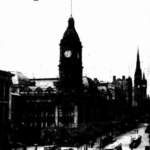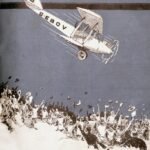
After 1903, 1911, 1913 and 1928, it’s time to round off this miscellany of Australian mystery aircraft with 1939 and 1940 — separated by little over a year in time, but quite far apart in place and circumstance.
The 1939 mystery aircraft was first seen, or rather heard, at Wellington, a small town in country NSW about 360km northwest of Sydney. The local newspaper’s aviation column recorded that
This (Friday) morning [19 May 1939], about 7 am, whilst there was a heavy mist, a plane flew over in the direction of Sydney, and as the wireless reports intimated heavy fog on the mountains and Sydney, I will be anxious to hear what happened to him, as it was quite evident the further he went east the worse the fog conditions would be, and the worse the flying country becomes from a landing point of view, particularly in fog.((Wellington Times, 29 May 1939, 9.))
The aeroplane (or a different one) appeared again on the following Friday, 26 May, this time being seen. It looked like ‘a military plane […] coming from the direction of Sydney’, initially ‘at a great altitude’ but then swooping down as ‘it circled round and round, apparently looking for a landing place’. It then seemed to signal ‘that all was all right’ to two policemen, and then flew back towards Sydney.((Wellington Times, 29 May 1939, 2.))
But the aeroplane was also said to have flown over Narromine, about 90 km further northwest:
Equally mysterious are three night visits which have been paid to Narromine in the past few weeks. The same procedure has been followed there. A plane has been heard overhead at night. It has flown in low over the aerodrome, remained for a few minutes and then roared away to the south, from which direction it had come.((Wellington Times, 29 May 1939, 3.))
Speculation about the identity of the mystery aircraft centred around some kind of training flight. The idea in Narromine was that ‘it might be a western flying instructor giving his pupils night flying instructions’.((Ibid.)) The Dubbo Liberal‘s aviation columnist likewise ‘surmise[d] that it is George Mendham training someone in night flying and using Narromine because of its brilliant lighting as a guide for the purpose.((Dubbo Liberal, 3 June 1939, 7.))
In Wellington, though, it was felt that the aeroplane heard there ‘seemed of higher speed and power than the type normally used for private training purposes’.((Wellington Times, 29 May 1939, 3.)) The suggestion, presumably, is that it was a military aircraft on a night navigation exercise. This seems quite plausible, given the RAAF’s expansion was now getting under way (three new squadrons had formed already at RAAF Richmond, the likely source of any such flights, in the first three months of 1939). And in fact, what seems to have been the very first mystery aeroplane flights over Narromine, on 3 May, was said by ‘officials of Richmond Aerodrome’ to probably have been ‘an Avro-Anson engaged in exercises’, as ‘One was out and about […] and would probably have been near Narromine about the time stated’.((Daily Telegraph (Sydney), 5 May 1939, 5.))
Interestingly — and this doesn’t seem to be reported in the local papers — this first visit brought locals into the streets:
Quite a stir was caused in Narromine last night [3 May 1939] when word came through that an aeroplane was flying towards Narromine from Peak Hill.
Many people were soon out watching for its arrival.
The plane circled the town, and then set a course apparently for Sydney, about nine o’clock, and at a height of about 4000 feet.((Ibid.))
What I can’t figure out is why. Narromine was a pretty airminded town — witness the aero club and the aviation columns in local newspapers; its aerodrome was an important stopover for cross-continental flights and had hosted several successful air displays — so everyone in Narromine would have been quite familiar with aircraft coming and going. What was so interesting about this particular aeroplane? The press gives no clue.
Bonus mystery aeroplane (among other things)! Later in June, ‘Thousands’ of people in Sydney were puzzled by a ‘mysterious light in the ‘south-eastern sky’ — was it ‘a balloon on fire, a comet rushing earthwards, [or] an aeroplane brilliantly lit’? None of the above: Mars, apparently.((Sunday Sun and Guardian, 25 June 1939, 2.))
The final mystery aircraft in this miscellany is from late August 1940, in what could almost be described as Australia’s ‘phoney war’ period, as no Australian forces were to be heavily engaged in action until December (in North Africa). It’s also not from Australia proper, but at Salamaua in the Territory of New Guinea, a former colony of Imperial Germany now administered as a League of Nations mandate. The incident was releyed to the Australian press by passengers on a ship from Rabaul, more than two weeks after it was all over, and consequently the story was given a heavy satirical spin.
‘[…] At noon one day a Government official at Salamaua suddenly discovered a brilliant white light in the sky. Yelling, “The parachutists have come,” he collected a couple of rifles and ammunition, rushed out to the aerodrome, and with a friend chartered Ray Parer’s Boeing plane.‘
‘For an hour the plane roared over Salamaua,’ said another passenger. ‘At first we all wondered what was the matter, but when the story got round that the official was serious about his “parachutists,” the whole town turned out and yelled with laughter.
‘There was no doubt about the brilliant white light. We all saw it, but it had nothing to do with “parachutists.” Because of some astronomical juggling, Venus at this time came in closer contact with another planet, and could clearly be seen at midday. Sometimes she seemed to have a tail like a comet.’ ‘The official will never live Venus down. The standing joke is to leave the poor girl alone.'((Sydney Morning Herald, 9 September 1940, 9.))
No identity for the ‘parachutists’ is given here, but there are a few clues as to what was going on. The obvious threat would seem to be Japan: Salamaua was on the north coastline of New Guinea, facing the Japanese-administered South Seas Mandate, and indeed was occupied by Japanese forces in March 1942. Australia was not yet at war with Japan, the article does refer to ‘New Guinea’s first enemy “parachutist”‘, and Germany was the enemy at this point, not Japan. As in the first war, there was the possibility of German raiders in the Pacific (which did soon eventuate), and perhaps it was feared that the Germans would take a special interest in its former colony. (Robert Loeffel, in his study of fifth column fears in Australia, does suggest that these extended to New Guinea even as early as 1939.)((Robert Loeffel, The Fifth Column in World War II: Suspected Subversives in the Pacific War and Australia (Basingstoke and New York: Palgrave Macmillan, 2015), 124.)) Also, the fears of parachutists and the use of the word ‘parashot’ (as in, an armed guard waiting for parachutists to fall from the sky) ties this to the sharp fear in Britain of German airborne troops after the fall of the France and the Low Countries. So the unnamed Australian official at Salamaua may have had Germany in mind as the enemy, but there’s no way to know, and anyway, paranoia, like the heart, has its own reasons which reason cannot understand.
There’s another version of the story, however. This was given in the Pacific Islands Monthly just a few days after the above story was published in the Sydney press, which it duly summarised. It then added that
a report in the ‘Rabaul Times’, of September 6 [1940], puts a different aspect upon the story. When the aviators returned, they insisted that the object they chased was a balloon, with a small basket floating below. They photographed it before it disappeared behind clouds. Salamaua jeered, of course.
Two days later the aviators got their own back. Four more balloons are said to have been seen floating over Salamaua district. One came very low. It is reported to have been about 6 ft in diamater, made of black rubber, with a small basket attached. The purpose of the balloons (or, as the doubters say ‘alleged balloons’) is a complete mystery.((Pacific Islands Monthly, vol. 11, no. 2 (September 1940), 10.))
So not only — according to this account — were the objects thought to be balloons rather the parachutists, but they reappeared a couple of days later, presumably seen by others, and definitely sounds very un-Venus-like. This all points this incident into the same category as one of the other great British air panics of 1940, the red balloon scare. Unfortunately I’ve found no trace of the photographs…
Image: Ray Parer’s Boeing 40H-4, via Len Dobbin collection.
![]() This work is licensed under a Creative Commons Attribution-NonCommercial-NoDerivatives 4.0 International License.
Permissions beyond the scope of this license may be available at http://airminded.org/copyright/.
This work is licensed under a Creative Commons Attribution-NonCommercial-NoDerivatives 4.0 International License.
Permissions beyond the scope of this license may be available at http://airminded.org/copyright/.




